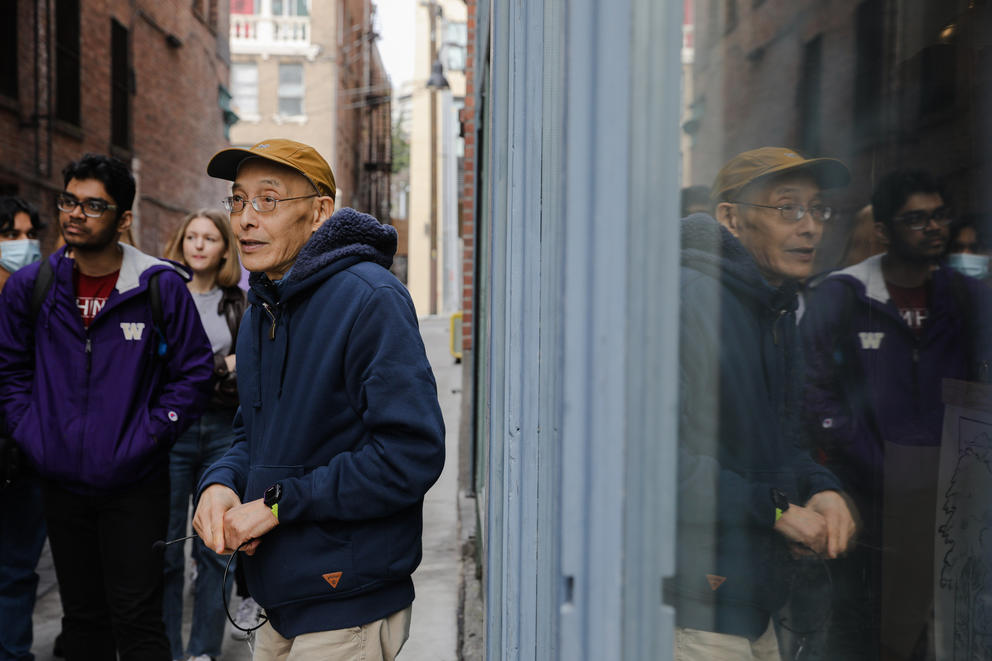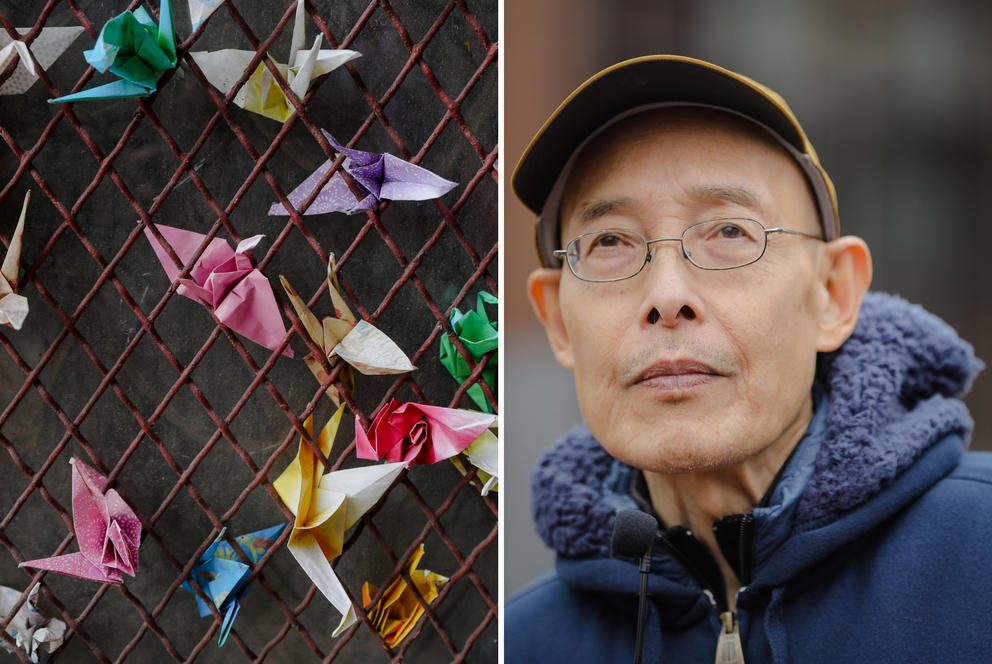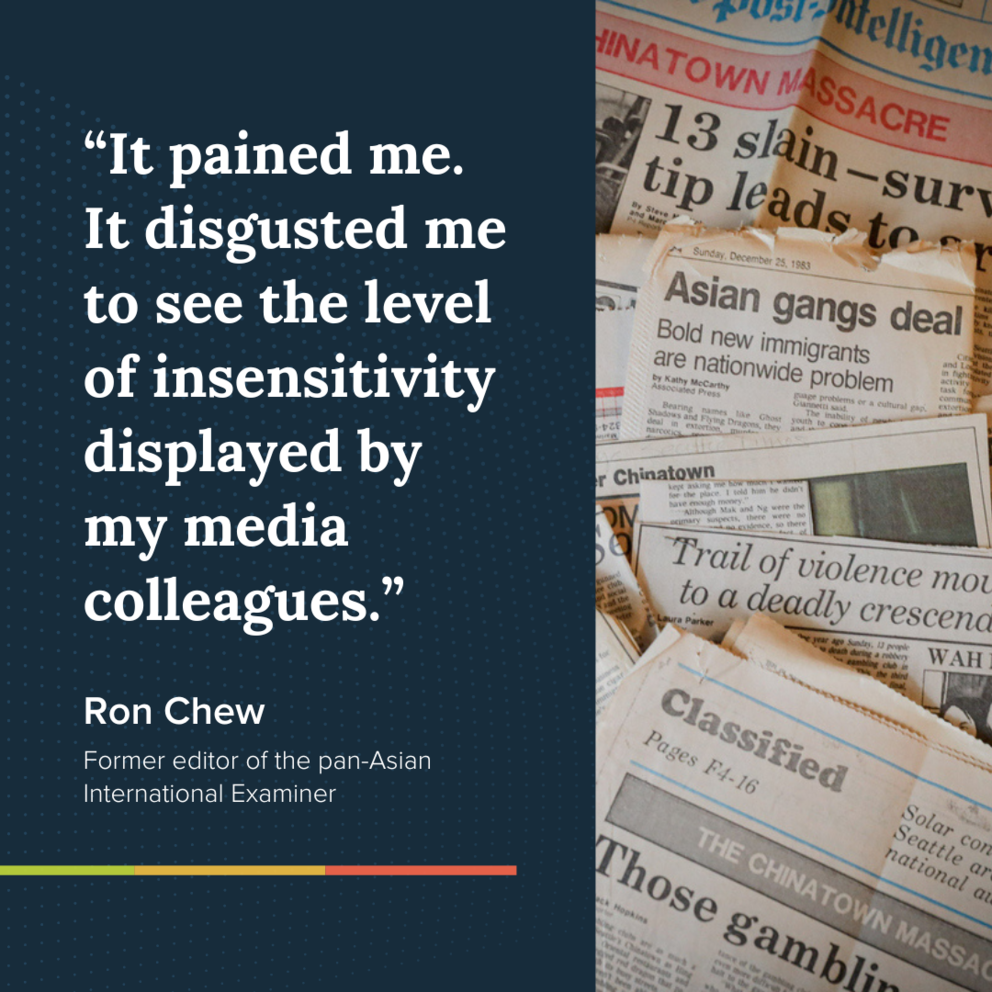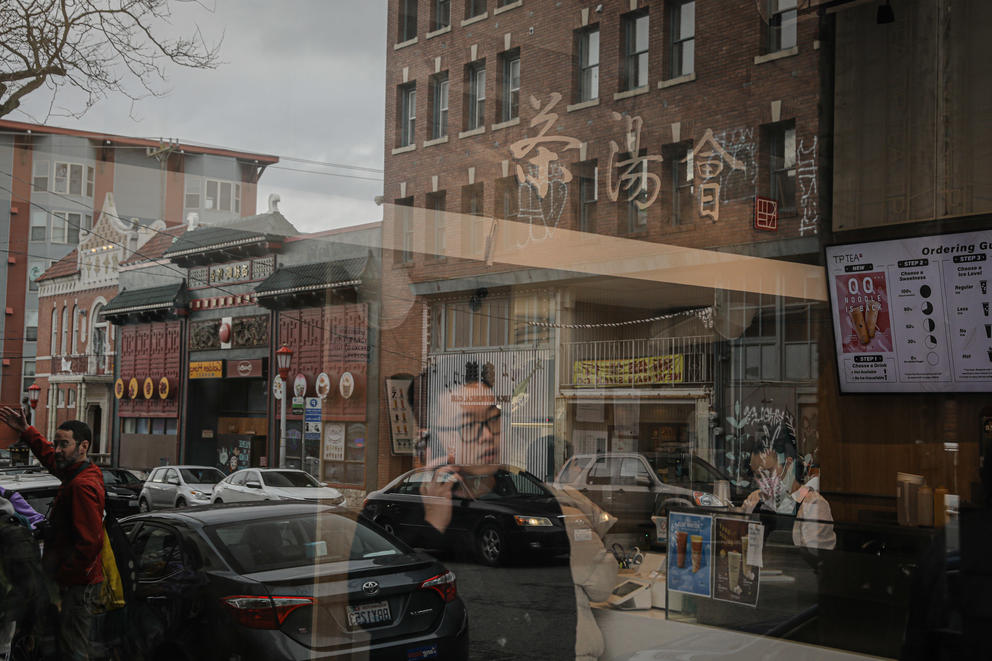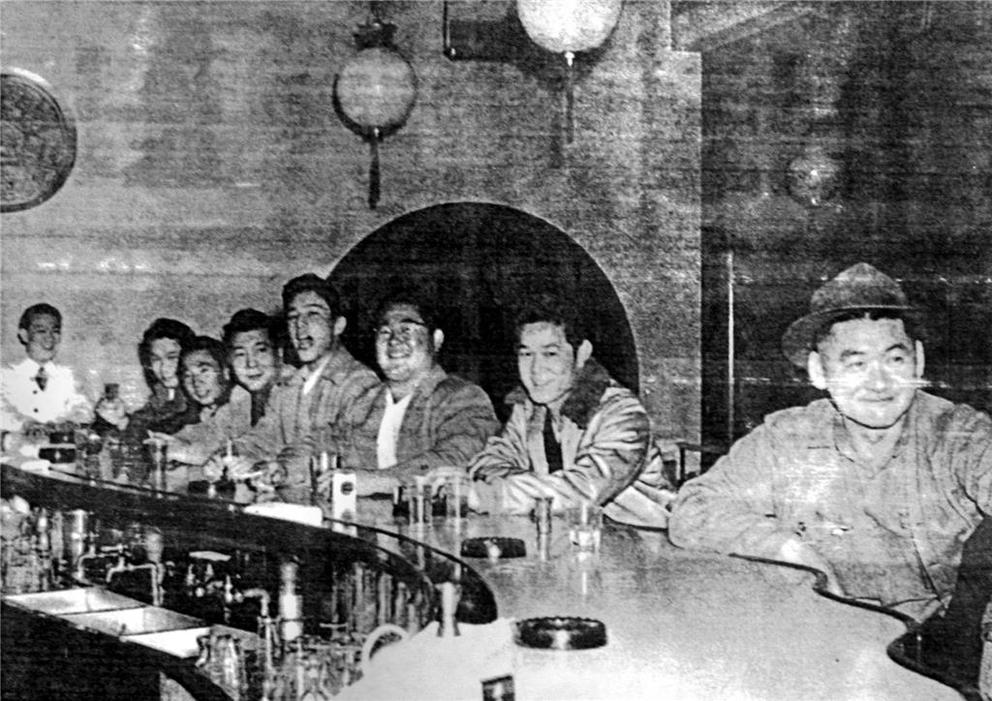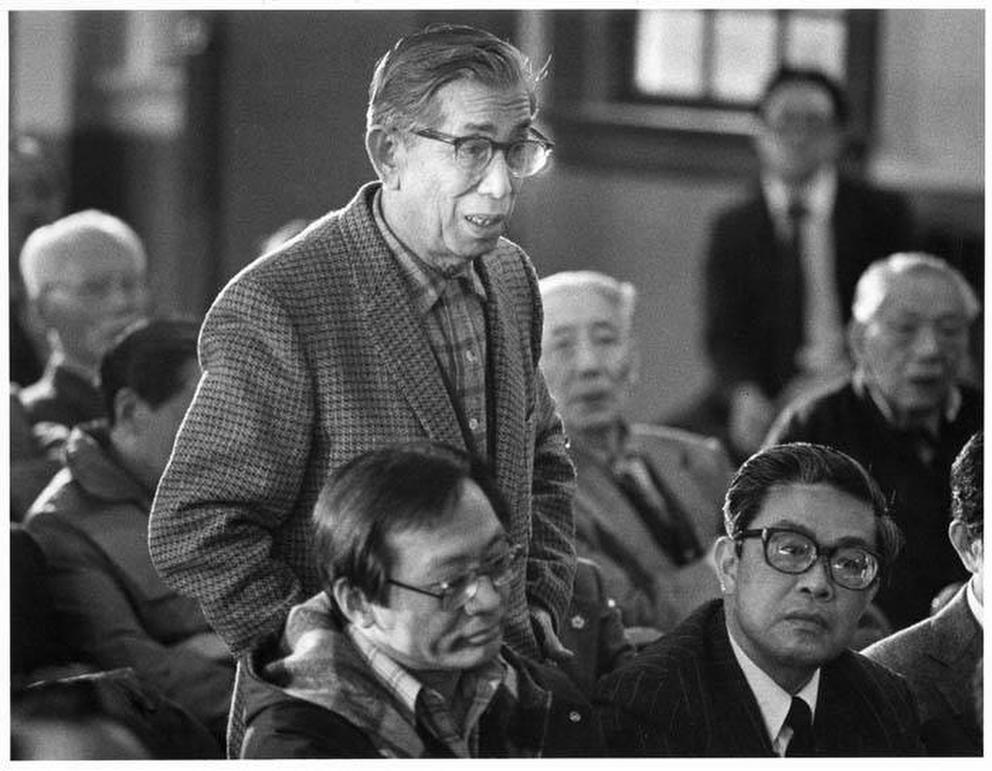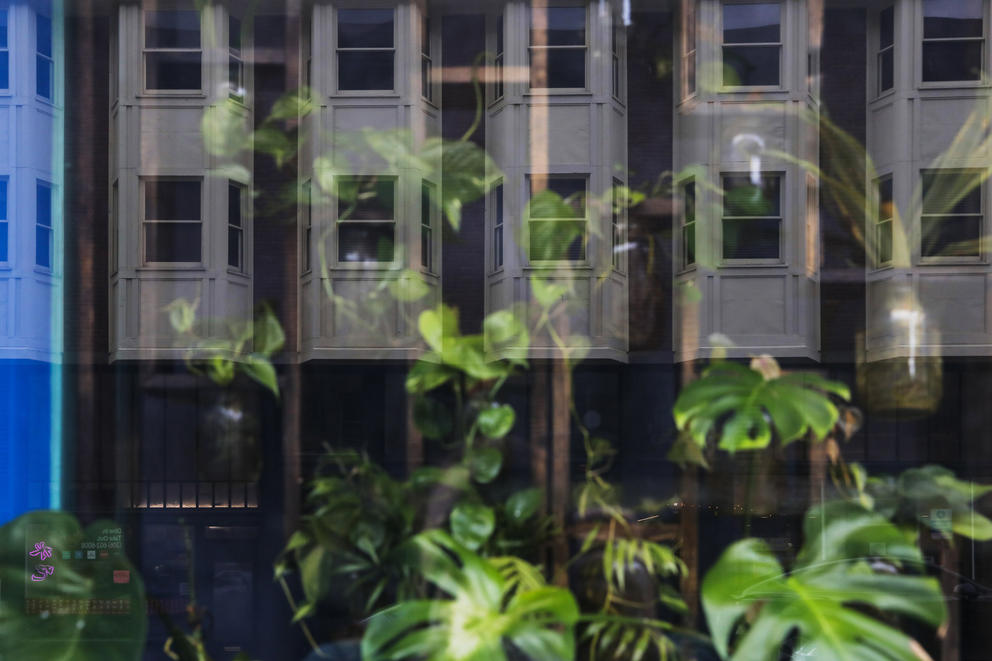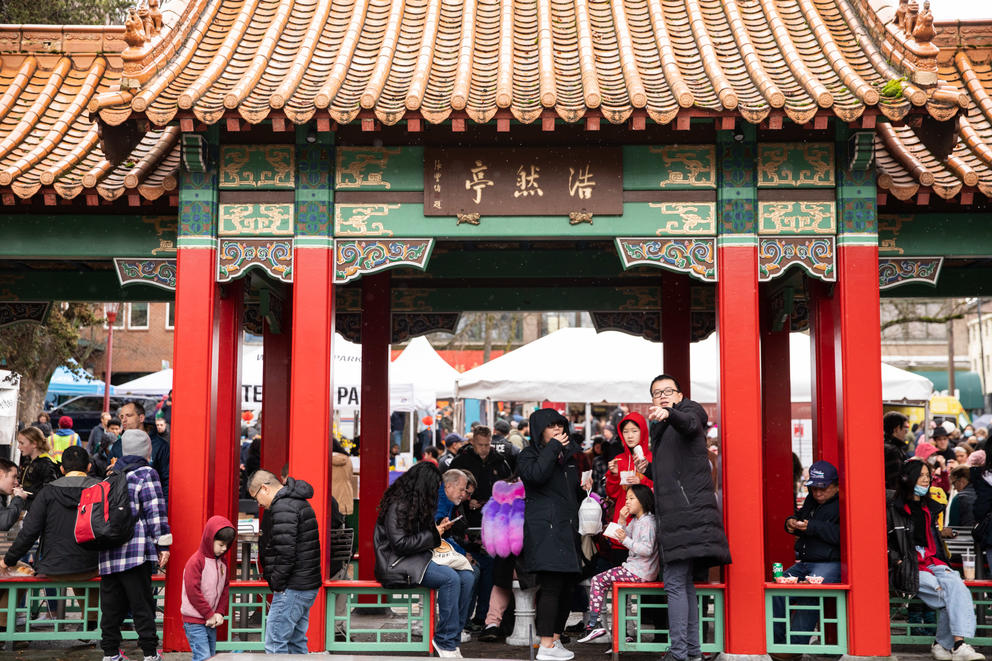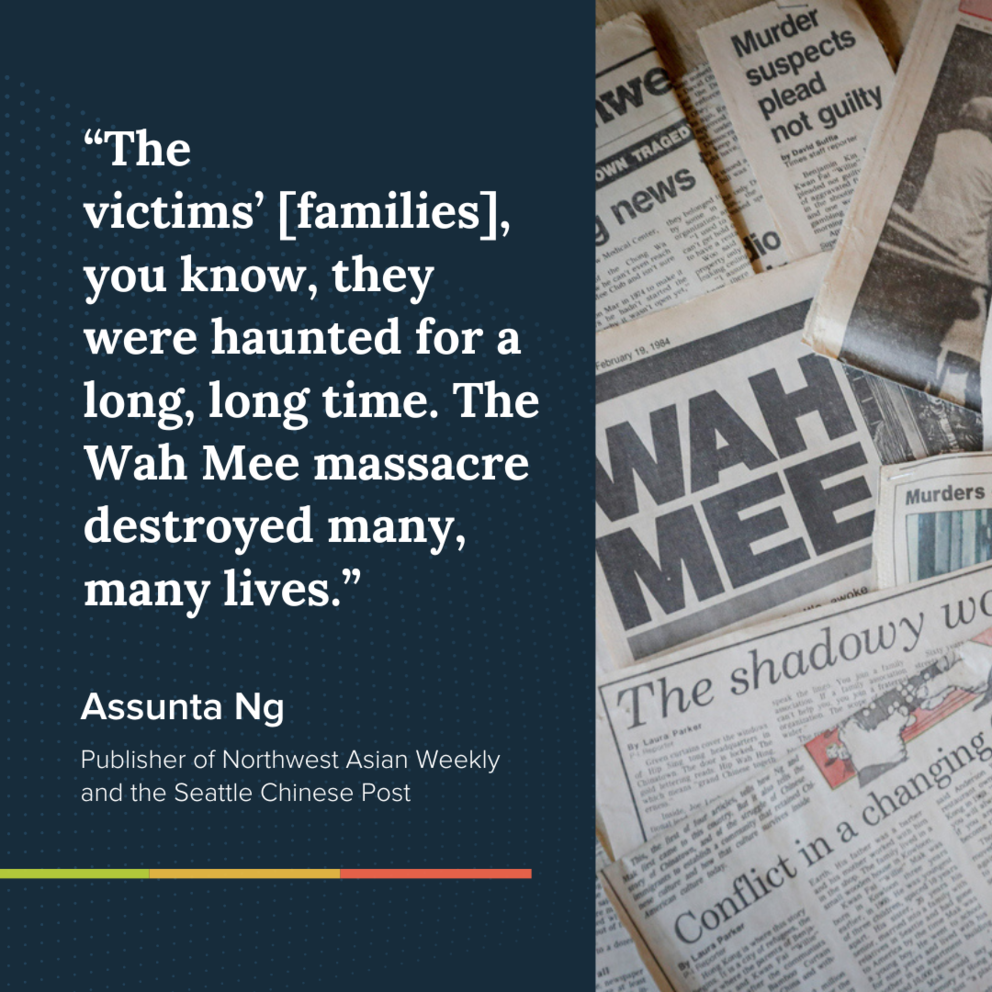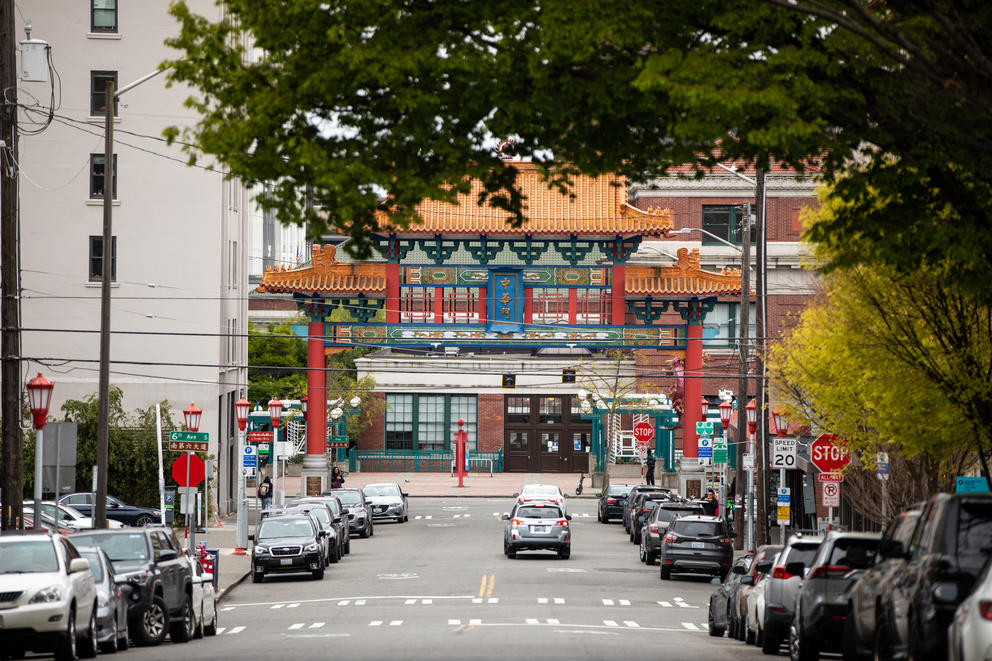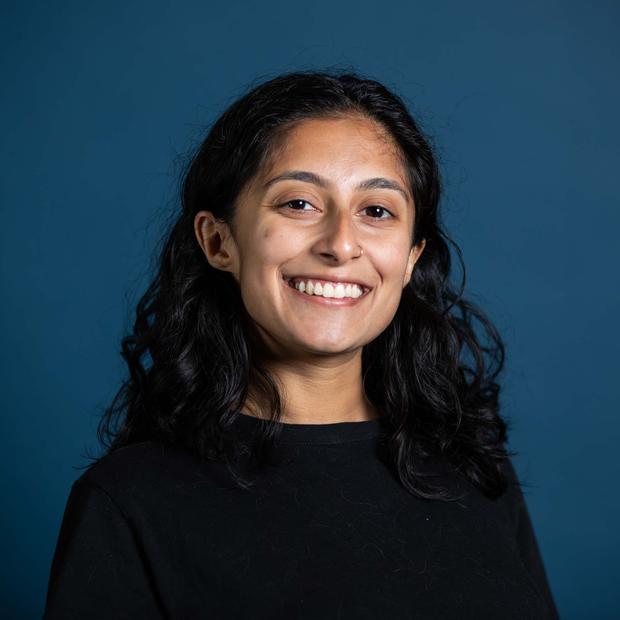The coverage continued for decades as media outlets revisited Wah Mee in anniversary pieces, like this one, and in stories that followed the perpetrators’ trials and later parole hearings.
History books remember the event at Wah Mee as the worst mass shooting in Washington history. In 1983, the Chinatown-International District was described mostly as a crime scene. Many Chinese Americans in Seattle, however, recall Feb. 19 as a day when their tragedy was forced onto a public stage.
Journalists love to look back at history, especially when an anniversary reaches a milestone year. But Wah Mee wasn’t just the name given to a horrific crime, it was a community space. Both the perpetrators and the victims were Chinese Americans, and many current residents knew or were related to someone involved.
Ron Chew, the former editor of the pan-Asian International Examiner, had a foot in the media realm and the community where he lived. He remembers being horrified by how news outlets covered Wah Mee.
“It pained me,” he said. “It disgusted me to see the level of insensitivity displayed by my media colleagues.”
The former editor of the pan-Asian International Examiner, Ron Chew, leads a group of UW students on a tour of the Chinatown-International District, giving them a historic perspective on the neighborhood, Jan. 27, 2023. The tour was part of a class titled “Cultural Landscapes of Seattle.” (Genna Martin/Crosscut)
The killings at Wah Mee became an instant sensation as reporters flocked to the neighborhood. Chew remembers news outlets publishing headlines that implied the communities were secretive, with one publication in particular running a graphic image of the victims.
For years, voyeurs paraded through the neighborhood, eager to catch a glimpse of the place. The relentless attraction of Wah Mee was a foreshadowing of today’s obsession with true crime and a desire to revisit tragic events in movies, books and Netflix series. The club never reopened, but unlike the sites of more recent Washington shootings – the Jewish Federation in Belltown and Marysville Pilchuck High School – the building where the tragedy happened is still standing as the Louisa Hotel.
The relentless pursuit of the story, racial stereotypes in media coverage, and long-term curiosity rubbed salt in wounds that may never have healed, even 40 years later. On the 20th anniversary in 2003, one victim’s sister begged local journalists to leave this story to the history books.
“The victims’ [families], you know, they were haunted for a long, long time,” said Assunta Ng, publisher of the Northwest Asian Weekly and the recently retired Seattle Chinese Post. “The Wah Mee massacre destroyed many, many lives.”
It forced the city’s Chinese and, more broadly, its pan-Asian residents into a spotlight that refused to dim. The aftermath of Wah Mee serves as a cautionary tale to outsiders, especially as marginalized groups like Asian Americans continue to experience violence.
Close-knit community
For many Asian American residents at the time, Wah Mee was scary, but it was also personal.
“The reason why most of us knew each other is because most immigrants to America follow a chain migration,” said Dr. Connie So, a professor in the University of Washington’s American Ethnic Studies department, who grew up on Beacon Hill. “We pretty much go where our relatives are at.”
So, an immigrant from Hong Kong, also attributed the community’s interconnectedness to Seattle’s segregationist practices, including its racially restrictive housing covenants, which weren’t completely outlawed until 1968. These practices effectively left only a few areas, like Chinatown and the Central District, accessible to minority groups. Asian and African Americans continued to struggle with living outside of certain neighborhoods, including Beacon Hill, the Central District, and Rainier Valley, well into the 20th century.
These covenants are now a thing of the past, but the legacy continues in the Chinatown-International District, which today remains one of the city’s most diverse neighborhoods.
The Chinatown Historic District, included in the National Register of Historic Places, has long served as a landing pad for Asian immigrants who lived, worked and recreated alongside one another. They saw each other through major changes over the years, including the building of Interstate 5, which split the neighborhood, and the destruction of older structures to accommodate updated fire and building codes. Community members set down roots and raised future generations in their neighborhood together.
Some residents illegally gambled at Wah Mee, a club that had been around since the 1920s.
“Going to these places is just a way for people to unwind,” So said.
But these communal experiences left people all the more rattled when they learned that Willie Mak, Benjamin Ng and Tony Ng – recognizable faces for many residents – were behind the robbery and murders at Wah Mee on Feb. 19, where 14 people were tied up, robbed and shot, leaving only one person who survived. Tony Ng later said that he took part because Mak threatened his family.
Ron Chew’s mother worked in a sewing factory alongside the mother of one of the perpetrators, while So and her siblings went to school with some of the perpetrators.
“Either you went to school with this person or that person worked in the same restaurant with one of the victims,” Ng of the Seattle Chinese Post said. “It’s very tightknit.”
The ongoing news coverage and sensation surrounding the killings forced the community’s grief into the public.
Media sensation and voyeurism
Hungry journalists did their job in the aftermath of Wah Mee, covering a tragedy that rocked the community. But from Chew’s perspective, they also exploited a vulnerable community navigating a deeply personal tragedy.
Left: Paper cranes are displayed outside Sun May on Canton Alley in the Chinatown-International District. The gift shop was opened by the Chin family in 1911 and has been passed down through three generations. Right: Ron Chew, the former editor of the pan-Asian International Examiner. (Genna Martin/Crosscut)
Chew wrote an opinion piece weeks after the event, calling out the media’s characterization of the families and neighborhood in general.
“In many cases, the relatives of those who were killed refused to talk to the press and, in several instances, press accounts described their refusal to talk in a manner implying that the families have something to hide,” he wrote.
Chew didn’t look at Wah Mee and the community only through a reporter’s lens.
“At the end of the day … I have to live in this community,” said Chew, who now lives on nearby Beacon Hill but lived in the Chinatown-International District for about a decade. “I can’t run off to the suburbs and cloister myself. These are people I know who were like uncles to me. And I grew up with their children. I interact with them. They’re not mysteries to me, they’re part of my world.”
A 2006 article in the International Examiner looks back, remembering reporters swarming the neighborhood and trying their luck at victims’ funerals. A narrative slowly emerged that residents were secretive, a perspective Chew challenged because – in addition to grieving – people were also scared: At that time, Tony Ng’s whereabouts were unknown to many, though he was later deported from Canada to the U.S. in October 1984.
Language barriers also made it difficult for residents who were not proficient English speakers to agree to interviews.
“You can’t communicate with them, that’s why they’re running away [from] you and shaking their head and everything else,” So said. “They’re trying to tell you they don’t speak English.”
Initiatives in recent years have responded to media issues like these, including the Narrative Justice Project, which trains communities of color in telling their own stories. The project’s website notes that it was founded as “a tactical response to structural racism in popular media representation and landscape.”
“You have, especially now, cable news, prime-time news, major media conglomerates, parachuting in and not knowing the actual cultures or communities,” said Dr. Rachel Grant, an assistant professor in the University of Florida’s Department of Journalism and the project’s research director.
Grant pointed to various ways the media can cause harm, from trying to get the emotional reactions of families who haven’t had time to process what’s happening around them to using language that characterizes people as “illegal” or “criminal.”
Grant acknowledged that many reporters are often doing a job that doesn’t always give them adequate time or space to go in-depth.
Ng of the Northwest Asian Weekly, which she started just weeks before Wah Mee, remembers the constant demands and deadlines in the aftermath that left her physically ill for a few days, especially as she tried to produce stories that differed from those in the mainstream.
Her publications offered a perspective that bigger news outlets couldn’t, like when the parents of one perpetrator used the Seattle Chinese Post, a Chinese-language newspaper, to apologize to the victims’ families.
Ng also encountered her fair share of criticism, such as when her newsroom ran an editorial condemning gambling, which many people thought shifted blame away from the murderers. A later editorial condemned the murders.
Ng thought more mainstream publications did a decent job in their coverage, hampered mainly by their lack of Asian American journalists on staff, and she even connected media to community members. Ng had a more sympathetic perspective on these reporters, who she felt were trying to do their jobs amid a dearth of information from tight-lipped police officers.
She also didn’t want people to stereotype the community, and was hopeful that coverage would help readers better understand these residents.
But over time, Ng started to shut out the media as well, knowing reporters would revisit the murders in anniversary stories that could perpetuate the narrative that the community was unsafe.
The voyeuristic response to Wah Mee continued well past the 1980s, as perpetrators went through first their trials, then a series of parole hearings. Companies ran tours that covered the event. News outlets also revisited the topic in updates on the perpetrators, including in 2014 when Tony Ng was deported to Hong Kong.
Present-day tragedies are not immune from the media frenzy that ensued after Wah Mee, and combating this requires more than just hiring a few diverse reporters, according to Grant.
“Representation – so having Black, brown, Asian reporters – does not necessarily translate to correct or equal reporting,” she said.
Instead, Grant called on reporters to be more culturally informed and understand the histories of those who have been disenfranchised or discriminated against over time.
Racism and isolation
Wah Mee put Seattle’s Asian American communities on edge, but it also illuminated their relationship with the broader population and, in some cases, isolated them further.
Chew said media outlets occasionally grabbed quotes from people who seemed to belong to the Asian community, even though the event largely impacted Chinese residents. So also remembered the media confusing someone who was not involved with the shootings with one of the perpetrators because they had similar names. (Ng said she made a similar flub at that time, although the person who was misprofiled laughed it off when they discussed it years later.)
News descriptions of the neighborhood as “shadowy” and of the event as the “Chinatown massacre” frustrated Chew, who said many of the victims actually lived closer to the Beacon Hill area. At the national level, a journalist at The Washington Post wrote that “the gambling societies have been shrouded in secrecy.”
“The media just began to, I think, really pander to stereotypes,” Chew said. “All of a sudden everybody became a caricature.”
When So was a freshman in college, she and a peer analyzed how news outlets reported on Wah Mee and on Asian Americans in general, finding these communities often characterized as model minorities or as gangsters and opium dealers.
People started to avoid patronizing area businesses after Wah Mee, according to Ng, who said the mainstream community held onto narratives that the event was gang-related rather than an isolated incident. So pointed out that the Roosevelt neighborhood didn’t experience the same lingering negativity after a shooter opened fire at the Cafe Racer coffee shop in 2012.
“A lot of us wanted to fight for a more accurate portrayal of our communities as well,” So said, adding this gave people a greater compassion for how they saw other marginalized groups portrayed.
Don Chin, a resident of Seattle's International District, asks Mayor Charles Royer and Seattle Police Chief Patrick Fitzsimons what is being done to protect his community in the wake of the murder of 13 patrons in the Wah Mee gambling club two days previously, on February 18, 1983. (Courtesy of MOHAI, 2000.107.265.07.01)
While Asian American communities had coexisted relatively peacefully with other Seattle groups at the time of the shooting, they did carry a recent history of isolation and exclusion. Mere decades before, the city’s Japanese Americans had been sent to incarceration camps by way of Executive Order 9066, and it had been only a century since xenophobic policies like the Chinese Exclusion Act of 1882 were enacted to limit the flow of immigrants to the United States.
Wah Mee happened during a decade when the nation was experiencing tensions with Asian countries, anti-immigrant sentiments, economic woes and international competition, Melissa Borja wrote for the Organization of American Historians.
There were several violent encounters around this time, including in Texas, where Ku Klux Klan members were setting fire to boats owned by Vietnamese shrimpers, and in Detroit, where two white men beat Vincent Chin, a Chinese American, with a baseball bat after accosting him because, they claimed, Japanese people were taking their jobs. (Chin eventually died.)
Those racial tensions continued through the decades, including when a local activist allegedly warned the late Cheryl Chow, a former educator and City Council member, that Wah Mee could happen again, which she interpreted as a threat.
“There are ebbs and flows,” Chew formerly of the International Examiner, said. “Events happen that affect and color how the community is perceived, and Wah Mee was one of those times. The pandemic is yet another time in which, you know, stereotypes rear their head and the community is under assault.”
Such events have continued. Asian Americans faced widespread xenophobia during the pandemic, including in Seattle, as political figures touted the “China virus” narrative on broadcast news platforms and social media.
Similarly, a 2021 shooting rampage at Atlanta-area spas – which culminated in the murders of eight people, including six Asian American women – prompted Angie Chuang, an associate professor of journalism at the University of Colorado Boulder, to call out “perpetual foreigner” stereotypes embedded in news coverage of the event.
Healing from trauma
Events like Wah Mee and the mass shootings in California last month may lead communities to feel a sense of shame about how they present to the world, according to David Takeuchi, a sociologist and professor at the University of Washington’s School of Social Work.
“Even if the shooters in the recent events have come from the Asian American communities, it’s still part of this general notion of how Asian Americans fit in,” Takeuchi said.
“Generational trauma,” a term that has entered the lexicon in recent years, may apply to those tied to Wah Mee. For example, Takeuchi explained that if trauma isn’t resolved – say, when someone internalizes it instead of sharing what they’re going through – there can be social consequences over different generations.
Similarly, he pointed to evidence that traumas incurred by a mother can biologically affect her child.
Our bodies don’t forget anything, according to Gloria Huh, a Seattle-based therapist who works mainly with Asian American and Pacific Islander clients – “even something slight, because our bodies have a way of remembering harm that’s done to our bodies, whether it’s emotional, psychological or physical.” Huh’s work often involves talking with clients about racial trauma and family issues from a culturally sensitive perspective.
All of this means that, though 40 years have passed, the trauma can still exist.
Huh stressed the importance of being mindful of the impact outsiders have on communities, which requires walking a fine line: For example, as a therapist, she is naturally curious for more details when her clients share difficult information, but she has to determine if asking for more is necessary for the client to feel heard and supported.
Takeuchi shared similar thoughts about neighborhood visits from curious outsiders.
“Some in that community may see it as exploitation of a tragic event,” Takeuchi said. “That raises the trauma again. Not that it’s not useful to go through the history, but it raises the issue of exploiting the event.”
He’s aware that such visits could continue until the end of time. But he urged people to consult community members, being mindful of their needs and what they would like to share about the event. This alone can be a step in the right direction.
The CID today
Community members have seen their neighborhood go through a lot, yet in many ways little has changed since 1983.
Ng remembers local restaurants getting “tremendous business” in the immediate aftermath of Wah Mee, but this quickly diminished as people grew wary of being in the neighborhood. Nearly 40 years later, in 2020, a store owner told Crosscut that she noticed a difference in foot traffic between her locations in the Chinatown-International District and on Capitol Hill, the latter being relatively unscathed as anti-Asian sentiments swept the nation.
The community, where many residents make low incomes and experience high poverty rates, recently pushed back against Sound Transit and homeless-shelter expansions into the neighborhood, harkening back to uproar in the 1970s over construction of the Kingdome.
The neighborhood still has community-led safety patrols, reminiscent of the late Donnie Chin’s International District Emergency Center, as residents continue to express concerns about drug dealing, property crime and violence in public spaces, and indicate a desire for increased police presence.
Despite this, So is glad she grew up in a diverse neighborhood, even if her upbringing was a byproduct of segregationist practices.
“I still live in Beacon Hill,” she said. “I wouldn’t live anywhere else.”
Chew also notices a new generation of people re-embracing the area, opting to live, work and volunteer in the Chinatown-International District.
The neighborhood was in a vulnerable position before Wah Mee, and has remained so in the years since. But Chew remains optimistic.
“I think every challenge to the neighborhood and the community is also an opportunity for the community to rise,” he said. “And find its voice.”
Listen to reporter Maleeha Syed discuss this story on the Crosscut Reports podcast:


